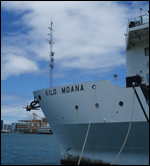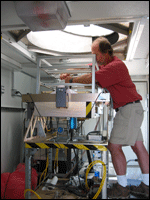WHOTS Research Cruise
June 30, 2009
 PSL Flux System installed on the R/V Kilo Moana (Photo credit: Sergio Pezoa) |
 Tom Ayers of PSL installs the W-Band Radar (Photo credit: Ken Moran) |
PSL personnel including Ludovic Bariteau of the Cooperative Institute for Research in Environmental Sciences (CIRES) and Diane Stanitski, a teacher from NOAA's "Teacher in the Lab" pilot program will participate in the Woods Hole Oceanographic Institute (WHOI) Hawaii Ocean Time-series Station (WHOTS) research cruise July 8-18, 2009. Based out of Honolulu, HI the WHOTS cruise will be changing out the Ocean Flux Reference site buoy at the WHOTS location using the University of Hawaii R/V Kilo Moana. This particular cruise will emphasize recent efforts to improve and validate buoy-based and ship-based solar radiative flux measurements. Using a portable flux standard, radiosondes, microwave radiometer, and a ceilometer, ESRL will provide high-quality observations for comparison with the buoy and the Kilo Moana in order to address general calibration issues. ESRL will also use a W-band radar to characterize clouds in the region.
In August 2004, the WHOTS project deployed a moored surface buoy instrumented with a full complement of meteorological sensors north of the Hawaiian Island of Oahu. The primary intent of WHOTS is to provide long-term, high-quality air-sea fluxes and observe heat, momentum, fresh water and chemical fluxes at a site representative of the oligotrophic North Pacific Ocean.
The Ocean Flux Reference sites and NOAA and University research vessels are the backbone of high-quality fluxes in the Ocean Observing system. ESRL is working with WHOI in a long term data quality assurance program.
| Contact: Chris Fairall | More Information: |